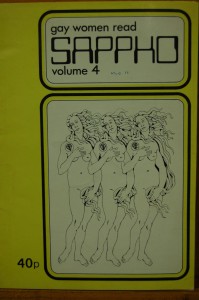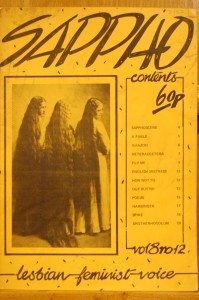To celebrate LGBT History Month, this month’s item from the Archive comes from the Lesbian Archive. In this post Alice Andrews, one of our volunteers, talks about Sappho magazine and its important role in Lesbian history.

Started in 1971, Sappho magazine was edited by Jackie Forster, a key member of the management committee that ran the Lesbian Archive and Information Centre (LAIC) whose archive forms a substantial part of the Glasgow Women’s Library collections.
Published monthly, Sappho was intended to act as a forum for lesbian women in the UK and elsewhere, providing women with information about groups, events and resources happening near them. From the start, the magazine intended that it should reach as wide a readership as possible, with the 7th Issue detailing events and organisations based in London, Cheshire, East Anglia, Sweden, Norway and Belgium. By its final issues, it was publishing details of organisations in Australia, the US, Canada, Finland and many other countries. As well as its international appeal, the breadth of information, local and national, the magazine provided for British lesbians was extensive, with the magazine offering contacts for groups and meetings, counselling and befriending sessions and lesbian religious organisations.
The magazine was run through voluntary contribution (even the editorial team’s contributions were voluntary), and as such relied on its readership to produce material, publicise and distribute the magazine. The fact that the magazine was able to sustain itself in this way for a decade reflects both the size of its readership, and the esteem in which it was held. This is not to say that contributions or help distributing the magazine were always readily forthcoming. In the issue for November 1976, a regular columnist in the magazine was impelled to write:
Either you want Sappho or you don’t. If you don’t then fine – it can fold, and each can fend for herself. If you do – and I think that lot of you do in fact value it- then get your fingers out and ACT. If you live out of London, then send some loot or write something- a letter, a poem – no-one expects you to be Dr Johnson or Virginia Woolf; and if you live in London, help with post outs and the Sappho Stall.
Rumour has it that Co-Ed [Jackie Forster] is lying heavily sedated in a darkened room, that Angie has lost three stone and twice as many lovers, and J.Y has applied for a visa in order to emigrate to Rumania; all as a result of trying to carry the whole load with too little help. Remember what John Donne said: “Never send to know for whom the bell tolls – it tolls for thee”.
That its readership had such an important role in the production of the magazine goes some way to explaining its success and its popularity. As well as this, the magazine had an open and flexible attitude to the thoughts and comments of its readership, publishing and acting on criticisms of the magazine. The esteem in which the magazine was held by its readers is unquestionable, with one reader commenting in one of the magazine’s final issues that “…it [Sappho] made me feel less alone. At first I thought I was some sort of freak and [I] need the reassurance your mag gave me.”
The magazine was published up until 1982 when it was forced to stop publication due to lack of funds. The organisation continued to keep its offices open, and to promote events and organisations for lesbians. However its influence was suddenly a lot smaller. As the later issues of the magazine show, the number of groups for lesbian and bisexual women had grown considerably in the years between 1971 and 1982, which Sappho and those attached to the organisation have to take a good deal of credit for this rise. Each issue of Sappho had a listings section that advertised these groups which grew considerably as the years went on.

In the final issue Jackie Forster reflected on the importance of Sappho and its future;
Sappho caused me to tramp the streets for miles and miles in London and other cities bearing our beautiful banner. I have fancied, been fancied, loved and been loved, love and am loved by unique and unforgettable women. Sappho caused me to write millions and millions of words about lesbians, to lesbians and women, about being lesbian- not only in the mag, but in books and other publications…. The magazine doesn’t date like a newspaper. Our articles, stories, poems and services still operate. Our cover says it all. Remember the three Botticelli beauties – lesbian, bi and straight in full frontals? Now they are turning away to move on to what the future holds.
As a young lesbian reading Sappho today, I am certain that Jackie Forster was certainly right about the magazine’s ongoing appeal. The letters, anecdotes, poems and stories still have the power to engage, anger and amuse.
Want to find out more about Sappho and other treasures held in the Lesbian Archive? Glasgow Women’s Library, in partnership with LGBT Youth Group the Rainbow Sisters, are holding an open day to celebrate LGBT History Month. We are also recruiting volunteers at this event to help work on making the Lesbian Archive more accessible. Click here to find out more information.
If you can’t wait until then, have a look at this video featuring Pam Currie. Pam helped set up the Lesbian Treasure Trunk which will be on display during the open day.
Two Decades of Changing Minds: Pam Currie from Glasgow Women’s Library on Vimeo.

3 replies on “Archive Item of the Month: Sappho”
[…] their lesbian archaive, so I could hold copies of the Arena Three (from 1964, 1965, 1968, 1969), Sappho and the articles of the never published creative writing newspaper called […]
[…] their lesbian archaive, so I could hold copies of the Arena Three (from 1964, 1965, 1968, 1969), Sappho and the articles of the never published creative writing newspaper called […]
[…] https://womenslibrary.org.uk/2012/02/09/archive-item-of-the-month-sappho/ […]